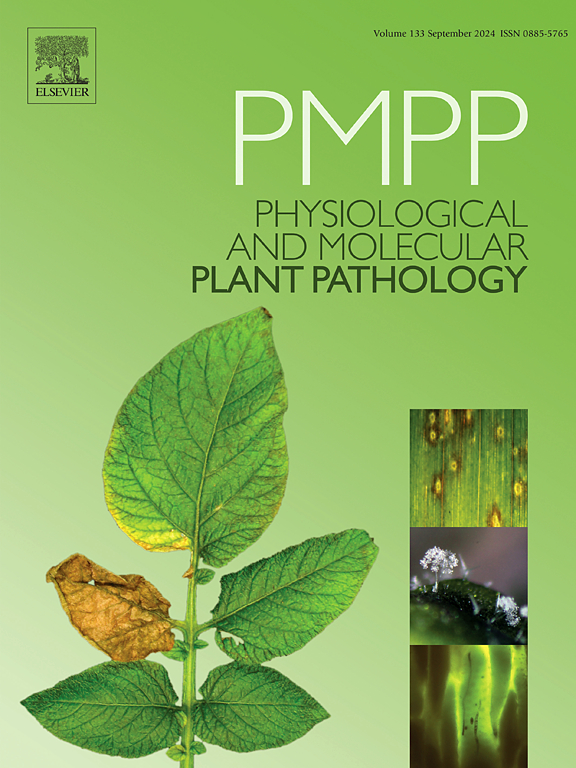Immunomodulator and marker-assisted identification of Allium genotypes containing immunological memory against anthracnose
IF 2.8
3区 农林科学
Q2 PLANT SCIENCES
引用次数: 0
Abstract
Allium cepa (onion) suffers significant yield losses due to anthracnose disease caused by Colletotrichum gloeosporioides. Current control methods, such as biocontrol agents, have limited effectiveness, while agrochemical applications pose risks to human health and the environment. Genomics-assisted breeding can be useful in getting a diverse genetic pool of wild Allium species to improve disease resistance in cultivated varieties. In this study, we used 42 intron length polymorphic and 22 chloroplast-based SSR markers to identify wild Alliums for anthracnose resistance. Genetic analysis using the marker data showed that two wild types, 6AfistAKO-17 and 15Afistul, are very different from the cultivated types. Immunomodulator benzo-thiadiazole-7-carbothioic acid S-methyl ester evoked a long-lasting immune response in wild Alliums. Transcriptome profiling showed that 131 immune-related genes were more than twice as active in wild Alliums compared to cultivated ones. These included MAPKs (7 genes), WRKY transcription factors (10), R genes (19), MYB transcription factors (28), cytochrome P450s (46), transcriptional activators (14), and other immune-associated genes (7). The results from the anatomical analysis showed that wild Alliums have more callose in their vascular bundles, thicker wax on their leaf surfaces, and closed stomata, which were confirmed by fluorescence and scanning electron microscopy, indicating that wild Alliums have a stronger immune system than the cultivated Alliums. Our findings suggest that wild Alliums possess both immunity and immune memory-related genes. This study suggests that molecular markers could help transfer the immunity-related genes from wild Alliums to cultivated Alliums to protect them from anthracnose infestation.
含有炭疽病免疫记忆的葱属植物基因型的免疫调节剂和标记辅助鉴定
洋葱(Allium cepa)因炭疽菌(Colletotrichum gloeosporioides)引起的炭疽病而遭受重大产量损失。目前的控制方法,如生物防治剂,效果有限,而农用化学品的应用对人类健康和环境构成风险。基因组学辅助育种有助于获得丰富的野生葱种基因库,从而提高栽培品种的抗病能力。本研究利用42个内含子长度多态性和22个叶绿体SSR标记对野生葱属植物进行了炭疽病抗性鉴定。利用标记数据进行遗传分析表明,野生型6AfistAKO-17和15Afistul与栽培型存在很大差异。免疫调节剂苯并噻二唑-7-碳硫酸s -甲酯在野生葱属植物中引起持久的免疫应答。转录组分析显示,野生葱中131个免疫相关基因的活性是栽培葱的两倍以上。其中包括MAPKs(7个基因)、WRKY转录因子(10个)、R基因(19个)、MYB转录因子(28个)、细胞色素p450(46个)、转录激活因子(14个)和其他免疫相关基因(7个)。解剖分析结果显示,野生葱维管束胼胝质较多,叶面蜡质较厚,气孔闭合,荧光和扫描电镜证实了这一点,表明野生葱比栽培葱具有更强的免疫系统。我们的研究结果表明,野生葱属植物具有免疫和免疫记忆相关基因。本研究提示,分子标记可以帮助野生葱属植物将免疫相关基因转移到栽培葱属植物中,以保护其免受炭疽病的侵害。
本文章由计算机程序翻译,如有差异,请以英文原文为准。
求助全文
约1分钟内获得全文
求助全文
来源期刊
CiteScore
4.30
自引率
7.40%
发文量
130
审稿时长
38 days
期刊介绍:
Physiological and Molecular Plant Pathology provides an International forum for original research papers, reviews, and commentaries on all aspects of the molecular biology, biochemistry, physiology, histology and cytology, genetics and evolution of plant-microbe interactions.
Papers on all kinds of infective pathogen, including viruses, prokaryotes, fungi, and nematodes, as well as mutualistic organisms such as Rhizobium and mycorrhyzal fungi, are acceptable as long as they have a bearing on the interaction between pathogen and plant.

 求助内容:
求助内容: 应助结果提醒方式:
应助结果提醒方式:


